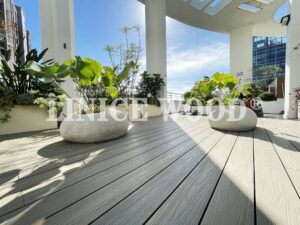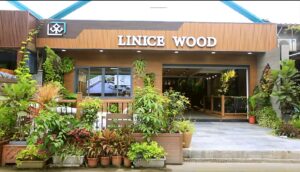When it comes to choosing materials for outdoor decking, Wood Plastic Composite (WPC) decks have surged in popularity. But with popularity comes myths and misconceptions. Today, we’re going to dive deep into the world of WPC decking, debunking common myths that might be steering you in the wrong direction.
If you’ve been led to believe that WPC decking is just a fancy, overpriced version of traditional wood decking, think again. This myth couldn’t be further from the truth, and it’s time to set the record straight.
Here’s the real deal: Today, I’m going to expose the most common WPC decking myths. Armed with facts and data, you’ll see why WPC decking might just be the game-changer your business needs.

Myth 1: WPC Decking Fades Quickly
Background: Many believe that WPC decks lose their color and look old within a year or two of installation, much like some early versions of composite decking did.
The Truth: Modern WPC decking is engineered with UV stabilizers and color retention technology. A study comparing traditional wood decks with WPC found that, while wood decks faded significantly, WPC decks retained much of their original color even after several years.
Busting the Myth: WPC decking’s durability against fading is not just a claim; it’s a proven feature, making it a smart investment for businesses looking for long-lasting outdoor solutions.

Myth 2: WPC Is Not Eco-Friendly
Background: Some argue that because WPC decking combines wood fibers with plastic, it’s not an environmentally friendly option.
The Reality: WPC decking is often made from recycled wood and plastic, reducing waste and promoting sustainability. Furthermore, its long lifespan means less frequent replacements, contributing to less waste over time.
Why It’s a Myth: Choosing WPC decking can actually be a part of your business’s green initiative, showcasing your commitment to sustainability.

Myth 3: WPC Decks Are Slippery When Wet
Background: There’s a common misconception that WPC decks become dangerously slippery when wet, posing a risk to users.
Evidence Against the Myth: Recent advancements have led to the development of slip-resistant WPC decking surfaces. Tests show that high-quality WPC decks can exceed the slip resistance standards set for commercial outdoor walking surfaces.
The Alternative: If safety is a concern, rest assured that modern WPC decking offers options designed to provide better traction, even when wet.

Myth 4: WPC Decking Looks Unnatural
- Background: Some people think that WPC decking can’t match the natural beauty of real wood.
- The Reality: Modern WPC decking comes in a wide range of colors and textures that mimic the look and feel of natural wood closely. Manufacturers have greatly improved the aesthetics, offering options that appeal to various preferences.
- Why It’s a Myth: With advancements in manufacturing techniques, it’s now possible to have a sustainable decking option that doesn’t sacrifice beauty for functionality.

Myth 5: WPC Is Difficult to Install
- Background: There’s a misconception that WPC decking requires special tools or expertise to install, making it more complicated than traditional wood decking.
- The Truth: WPC decking is designed for easy installation, often featuring a clip system that reduces installation time and complexity. In many cases, it can be more user-friendly to install than traditional decking materials.
- Busting the Myth: The ease of installation can actually save time and labor costs, making WPC decking an efficient choice for businesses.

Myth 6: WPC Decking Can’t Be Repaired
- Background: A common myth suggests that if a WPC deck is damaged, it can’t be repaired but must be completely replaced.
- Evidence Against the Myth: While WPC decking is highly durable, minor repairs can be made. For example, scratches can often be lightly sanded out, and individual boards can be replaced if necessary.
- Why It’s a Myth: The notion that WPC decks are a write-off if damaged is outdated. With proper care and maintenance, WPC decking can last and maintain its appearance for many years.

Myth 7: WPC Decking Is Too Expensive
- Background: Initial cost comparisons might show WPC decking as more expensive than traditional wood.
- The Reality: When considering the lifespan, maintenance costs (such as staining, sealing, or repairing), and durability against the elements, WPC decking often proves to be more cost-effective in the long run.
- Busting the Myth: A comprehensive cost analysis shows that the investment in WPC decking can pay off, making it a smart financial decision for businesses looking for long-term value.

Myth 8: WPC Decks Are Bad for the Environment
- Background: It’s easy to assume that because WPC decking contains plastic, it’s not an environmentally friendly choice.
- The Truth: WPC decking is made from a blend of recycled wood fibers and plastics, reducing landfill waste. Additionally, its durability means less frequent replacement and, therefore, less environmental impact over time.
- Why It’s a Myth: WPC decking supports sustainability efforts by utilizing recycled materials and offering a long-lasting solution that minimizes waste.
LiNice Wood – One of The Leading WPC Composite Decking Manufacturers in China
We are LiNice Wood, a leading WPC Composite company in China. We’ve helped many clients wholesale and customize WPC composite decking from China. If you want to import composite decking from China, please feel free to CONTACT US.
We’ve tackled some of the most stubborn myths about WPC decking head-on. Far from being just another decking option, WPC offers durability, sustainability, and safety benefits that traditional materials can’t match.
Which of these debunked myths surprised you the most? Are there other misconceptions about WPC decking you’ve encountered? Share your thoughts.





